Spiti Valley, a cold desert mountain valley located high in the Himalayas, is one of India’s most stunning and remote destinations. Known for its stark beauty, ancient monasteries, and unique culture, Spiti Valley offers an unparalleled experience for those seeking adventure, serenity, and a connection with nature. In this comprehensive guide, we will walk you through everything you need to know about traveling to Spiti Valley, from the best time to visit to the must-see attractions and practical tips for making the most of your journey.
Spiti Valley, often referred to as “Little Tibet,” is a haven for travelers looking to explore the unexplored. The valley is surrounded by towering snow-capped peaks, deep gorges, and vast stretches of barren land that create a landscape like no other. What makes Spiti truly special is its isolation from the rest of the world, offering visitors a chance to disconnect from the hustle and bustle of urban life and immerse themselves in an environment that feels almost otherworldly.
Spiti is home to some of the oldest Buddhist monasteries in the world, including Key Monastery, Tabo Monastery, and Dhankar Monastery. These monasteries are not only spiritual centers but also architectural marvels that have stood the test of time. The valley’s Tibetan Buddhist culture is deeply ingrained in every aspect of life, from the prayer flags fluttering in the wind to the simple, yet profound, way of life of the Spitians.
For the adventure enthusiasts, Spiti Valley offers numerous trekking routes, with breathtaking views and opportunities to explore remote villages that are accessible only by foot. The Pin Parvati Pass, Chandratal Lake, and the Spiti-Lahaul circuit are some of the most popular trekking destinations. The rugged terrain and high altitude also make Spiti a perfect destination for mountain biking, camping, and exploring the lesser-known trails.
The best time to visit Spiti Valley depends on what you wish to experience. The valley experiences two distinct seasons—summer and winter—each offering a different perspective of this Himalayan gem.
Summer is the most popular time to visit Spiti Valley. The weather is relatively mild, with temperatures ranging from 15°C to 20°C during the day. The snow melts, and the roads are open, making it easier to access the valley. This is the best time for sightseeing, trekking, and enjoying the lush green landscapes interspersed with patches of snow.
Winter in Spiti Valley is harsh and cold, with temperatures often dropping below freezing. However, for those who love snow and are up for a challenge, winter can be a magical time to visit. The valley is covered in a blanket of snow, the villages are isolated, and the frozen rivers and lakes create a surreal landscape. It’s important to note that many roads and passes are closed during winter, and the only way to reach Spiti is via the Shimla route.
Reaching Spiti Valley is an adventure in itself. The valley is accessible via two main routes—one from Manali and the other from Shimla. Each route offers a unique travel experience and varies in terms of the difficulty level and scenic beauty.
The route from Manali to Spiti Valley is shorter but more challenging. The journey takes you through the famous Rohtang Pass and Kunzum Pass, which are known for their unpredictable weather and road conditions. This route is usually open from June to October. The drive is both thrilling and beautiful, with stunning views of the Pir Panjal range and the Spiti River.
The Shimla route, although longer, is more gradual in its ascent, making it a preferred choice for those prone to altitude sickness. This route remains open throughout the year, except during heavy snowfall. The journey from Shimla takes you through the lush green valleys of Kinnaur, offering a gradual transition into the stark landscapes of Spiti.
Spiti Valley is dotted with ancient monasteries, pristine lakes, and remote villages that offer a glimpse into a way of life that has remained unchanged for centuries. Here are some of the must-visit places in Spiti Valley:
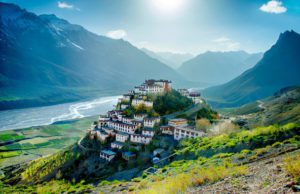
Key Monastery, perched on a hilltop overlooking the Spiti River, is the largest and oldest monastery in the valley. It is a center of learning and houses a large collection of ancient Buddhist texts, paintings, and statues. The monastery’s architecture is a sight to behold, with its whitewashed walls and tiers of rooms and prayer halls.
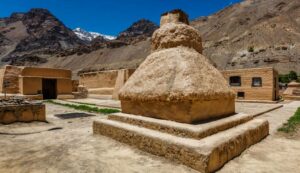
Known as the “Ajanta of the Himalayas,” Tabo Monastery is one of the oldest and most important monasteries in Spiti Valley. The monastery complex is a UNESCO World Heritage Site and is renowned for its exquisite wall paintings and ancient frescoes that date back to the 10th century.
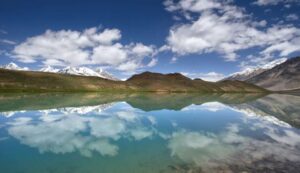
Chandratal Lake, also known as the “Moon Lake,” is a high-altitude lake located in the Lahaul and Spiti district. The lake’s crystal-clear waters reflect the surrounding snow-capped peaks, creating a breathtaking view. It is a popular destination for trekkers and campers, and the journey to the lake offers stunning views of the barren landscapes of Spiti.
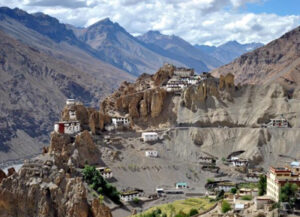
Dhankar Monastery, perched precariously on a cliff, offers panoramic views of the Spiti Valley. The monastery is a testament to the architectural ingenuity of the early inhabitants of Spiti. The village of Dhankar, located nearby, is also worth a visit for its ancient structures and traditional Spitian way of life.
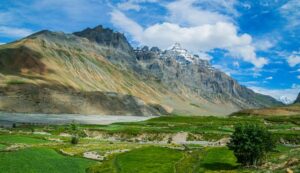
Pin Valley National Park is a protected area that is home to a variety of wildlife, including the elusive snow leopard, Siberian ibex, and Himalayan marmot. The park is also known for its beautiful landscapes, with vast expanses of alpine meadows, deep gorges, and snow-capped peaks.
Traveling to Spiti Valley requires careful planning, especially due to its remote location and high altitude. Here are some practical tips to ensure a safe and enjoyable trip:
Spiti Valley is located at an altitude of over 4,000 meters, making altitude sickness a real concern. It is important to acclimatize properly by spending a couple of days at lower altitudes before ascending to Spiti. Staying hydrated and avoiding strenuous activities during the first few days can also help prevent altitude sickness.
The weather in Spiti can be unpredictable, even during the summer months. It is essential to pack warm clothing, including thermal wear, jackets, and gloves. A good pair of trekking shoes, sunglasses, sunscreen, and lip balm are also must-haves.
ATMs are scarce in Spiti Valley, and many places do not accept card payments. It is advisable to carry enough cash to cover your expenses throughout your trip. The last reliable ATM is in Kaza, the sub-divisional headquarters of Spiti.
The people of Spiti Valley are deeply religious and follow a simple, traditional way of life. It is important to respect their customs and traditions, especially when visiting monasteries and religious sites. Always ask for permission before taking photographs of people or their homes.
Spiti Valley is an ecologically sensitive area, and it is our responsibility to preserve its pristine beauty. Avoid littering, use biodegradable products, and be mindful of your impact on the environment. Supporting local businesses and staying in homestays can also contribute to the local economy.
Traveling to Spiti Valley is an unforgettable experience that offers a perfect blend of adventure, culture, and natural beauty. Whether you are trekking through its rugged terrain, exploring its ancient monasteries, or simply soaking in the serenity of its landscapes, Spiti Valley will leave you with memories that will last a lifetime. Plan your trip carefully, respect the local culture, and embrace the unique charm of this Himalayan paradise.
Enter your contact details and we will plan the best holiday suiting all your requirements.
